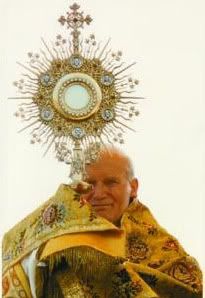Co-Cathedrals
A co-cathedral is pretty close to being exactly what it sounds like. Of course, a diocese can only have one actual (full) cathedral. Some sources insinuate that there are dioceses with co-equal co-cathedrals, but this is not the case. This can be demonstrated by looking at the dioceses with co-cathedrals -- all of them also have a church that is the "cathedral" straight up. The co-cathedral, however, is church that serves as the chief church for a part of a diocese (inferior to the cathedral) or that has been assigned the title as an honor for past importance. The origins of the co-cathedral will have to be found by someone with better resources than I, for neither the web nor our library's meager database resources have been adequate to reveal it to me. However, for a thing of such mysterious background, it seems to be relatively common.
Most common is the incidence of a diocese that has been consolidated into another, in which case one of the cathedrals remains the home church for the whole diocese and the other is relegated to co-cathedralism. Some of these churches seem simply to bear an honorary title, but others of them, like St. Joseph in the Diocese of Houma-Thibodaux, appear actually to retain a cathedra, as can be seen in this photograph. In this regard, they function like a home away from home for the bishop. The term co-cathedral is absent from the Code of Canon Law, but it would appear that the bishop could exercise all the same duties in a co-cathedral as in a full cathedral, and the distinction must be one of "should ordinarily" [celebrate in the full cathedral] versus "could" [go and do so in the co-cathedral]. It would also seem that a co-cathedral would not require the large administrative retinue that the cathedral itself requires.
A few dioceses, such as Galveston-Houston, were renamed to incorporate a second city, but kept the same geographic area. In such instances, a co-cathedral is designated or built to serve the bishop when he travels to the second city. This situation seems to occur when a second large urban area sprouts up within an already established diocese, but is too close to the diocesan seat to form its own diocese. St. Paul-Minneapolis is another example.
There are also those churches which, not being in amalgamated dioceses, but simply being former cathedrals or important churches within the same diocese, are elevated to the status of co-cathedral as an honorary title. This is mentioned and even promoted in this apostolic Decree. The Diocese of Louisville contains a co-cathedral in Bardstown, which was at one point the diocesan seat.
The Diocese of Honolulu has yet another situation, in which the diocese outgrew the cathedral, but did not want to move the diocesan seat. They erected a new parish with a larger church building and designated it as the co-cathedral, so that the diocese would have a space to accommodate the large crowds for special occasions.
Europe has co-cathedrals too. Poland seems to have a good number of them. If you speak Polish, you can probably find out lots about them. Perhaps the most notable co-cathedral is that of the Archdiocese of Malta, the Co-cathedral of St. John. This magnificent church was built by the Knights of Malta in the 16th century and later raised to the status of co-cathedral when one of the order's Masters General was elected pope and bestowed a favor upon his home parish. (The actual cathedral of the Archdiocese of Malta is the Cathedral of Mdina.)
Other US dioceses with co-cathedrals include Wheeling-Charleston, Pensacola-Tallahassee, Great Falls-Billings, Kansas City-Saint Joseph, and Samoa-Pago Pago (in American Samoa).
File Under: Catholic_Stuff, History








1 Comments:
Technically speaking, there are actually *lots* of "co-cathedrals" in Europe as a result of the Protestant Revolution. Many cathedrals in England, like those at Canterbury, Winchester and York, are still technically cathedrals. Because they were seized by the Protestants during the religious upheavals, they were never officially de-consecrated and whatnot, and, according to canon law are still owned by the Church, despite the fact that they have been usurped.
Although the fact that the dioceses in England weren't re-established until the 19th century (and, in fact, are different than the originals), the cathedrals from pre-Church of England are still technically property of the church, are still technically Catholic cathedrals and therefore the new cathedrals built by Catholics have the status of co-cathedral.
This is especially in evidence in Dublin, where the original Catholic cathedral was seized by Anglicans and the Catholics built another one- so Dublin technically has two cathedrals.
Post a Comment
<< Home